Enneagram Personality Classifications
The purpose of this blog is to provide a beginner’s level overview of the Enneagram.
While simple on the surface, the more you dig, the more complex and intriguing this conceptualization of personality becomes.
So, just in case you want more (because why the heck wouldn’t you 😉), I’ll put some more resources at the bottom to help you dig deeper.
For now, let’s start with the image of the Enneagram.
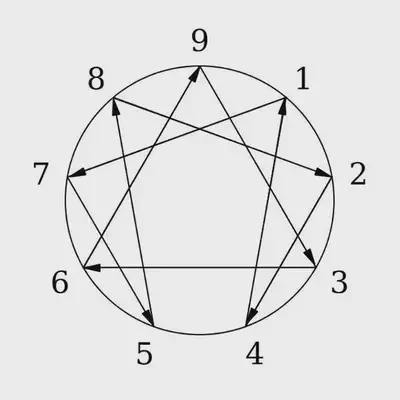
Types
The Enneagram uses numbers to describe categorical styles of personality because there is no positive or negative connotation for numbers like there are for words; no personality is more or less valuable/better than another. Each personality has strengths and weaknesses. Over time, however, we have assigned some basic words to each type. Additionally, it is mostly agreed that we are born with a dominant personality style that helps us interact with our world and develop, and that core personality does not change to another style, though we can grow and adapt. There is also a concept of a childhood wound that influences personality development. Further, you won’t perfectly fit into your core personality style all the time because of growth, stress, health, and other environmental factors.
Now, this is where the Enneagram becomes super complex. Within each type, there is a continuum of health or “levels of development,” three different subtypes based on instinct (creating 27 types), and wings. I’m not going to go into the levels of development because it’s basically a continuum from unhealthy to healthy. The three different subtypes of each personality include the following instincts: self-preservation, sexual, and social. Self-preservation (Sp) highlights a focus on maintaining life, self-protecting, and surviving. The sexual instinct (Sx) focuses on relationship and attachment to create generations. The social instinct (So) values social connection and secure bonds to others. Thus, for example, a Sp 2, Sx 2, and So 2 are going to be quite different. Next we have wings, which are controversial in the literature regarding both its existence (or nonexistence) and functioning. Without going too deep, wings are which style you lean toward next to your own. For example, a 1 can be a 1w9 or 1w2; a 2 can be a 2w1 or 2w3; and a 3 can be a 3w2 or 3w4. Remember, wings can only be the number before or after your own number.
| Type | At Their Best | At Their Worst | Struggle | Ideal |
|---|---|---|---|---|
| 1 ONE |
●Honorable ●Idealistic ●Virtuous ●Conscientious | ●Judgmental ●Critical ●Controlling ●Rigid | Anger | Serenity |
| 2 TWO |
●Caring ●Considerate ●Helpful ●Passionate | ●Manipulative ●Selfish ●Martyr-like ●Ambiguous | Pride | Humility |
| 3 THREE |
●Confident ●Pragmatic ●Vigorous ●Positive | ●Superficial ●Vain ●Fraudulent ●Grandiose | Self-Deceit | Truthfulness |
| 4 FOUR |
●Artistic ●Empathetic ●Reflective ●Emotional | ●Moody ●Egotistical ●Detached ●Ashamed | Envy | Equanimity |
| 5 FIVE |
●Logical ●Perceptive ●Objective ●Sensitive | ●Passive ●Cold ●Stingy ●Pessimistic | Avarice | Non-Attachment |
| 6 SIX |
●Capable ●Dependable ●Steadfast ●Supportive | ●Cantankerous ●Erratic ●Oppositional ●Suspicious | Fear | Courage |
| 7 SEVEN |
●Charismatic ●Sunny ●Exuberant ●Assured | ●Self-absorbed ●Impulsive ●Inconsistent ●Unruly | Gluttony | Sobriety |
| 8 EIGHT |
●Straightforward ●Dynamic ●Down-to-earth ●Protective | ●Aggressive ●Crass ●Dictatorial ●Selfish | Lust | Innocence |
| 9 NINE |
●Acceptant ●Calm ●Gracious ●Harmonious | ●Inattentive ●Zoned out ●Indifferent ●Passive-aggressive | Sloth | Action |
Centers
The Enneagram has three centers. The body center contains instincts felt in the gut and is focused around anger, which encompasses the 8, 9, and 1 personality styles. The heart center contains feelings/emotions and is focused around shame, which encompasses the 2, 3, and 4 personality styles. The head center contains thinking/cognition and is focused around fear, which encompasses the 5, 6, and 7 personality styles.
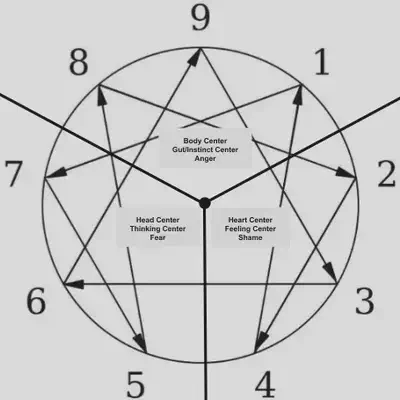
Within each of these centers, the three different types interact differently with the center’s focus. In the heart center, 2s overdo or express their shame outwardly, 3s underdo their shame and hold it all in, and 4s are conflicted about their shame and turn it inward but run from it. In the head center, 5s overdo or express their fear outwardly, 6s underdo their fear and hold it all in, and 7s are conflicted about their fear and turn it inward but run from it. In the body center, 8s overdo or express their anger outwardly, 9s underdo their anger and hold it all in, and 1s are conflicted about their anger and turn it inward but run from it.

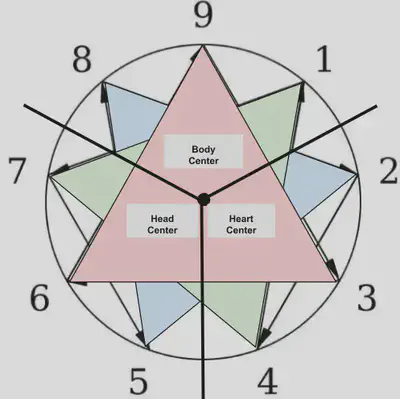
Growth and Stress Pathways
Again, the complexity and dynamic nature can be found in the pathways between types. The pathway of growth or “direction of integration” means that when we are in relaxed and balanced conditions, we move toward health/growth by taking on some of another type’s traits. The pathway of stress or “direction of disintegration” means that when we are in stress (external or internal) we move toward less helpful/resourceful traits of another’s type. Notice that types 3, 6, and 9 (9-3-6-9) are connected, moving clockwise around their triangle in growth and counterclockwise in stress (9-6-3-9). The other types then follow the growth pattern of 1-7-5-8-2-4-1 and go backward in the stress pattern of 1-4-2-8-5-7-1.
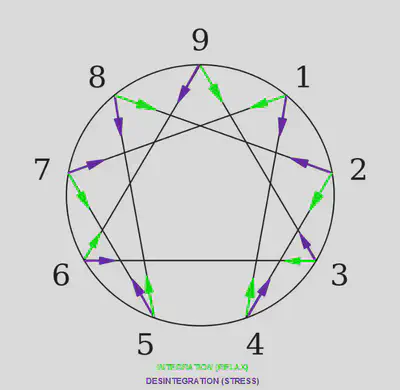
There are so many other facets and pieces of the Enneagram that weren’t discussed here. My favorite part about the Enneagram is its dynamic nature. One 5 is not going to look like another 5, though there will be commonalities, due to variables like wings, growth/stress pathways, instincts/subtypes, and levels of development. I like to think about it like this ball of color hues - everyone falls a little differently on it. While there are categories because our brains chunk information to understand, all the main colors contain so many variations!
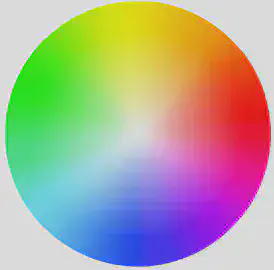
To learn more about the Enneagram, see these resources for more information.
References
- Enneagram Made Easy: Discover the 9 Types of People by Elizabeth Wagele and Renee Baron
- The Road Back to You: An Enneagram Journey to Self-Discovery by Ian Morgan Cron and Suzanne Stabile
- The Wisdom of the Enneagram: The Complete Guide to Psychological and Spiritual Growth for the Nine Personality Types (Faith-Based) by Don Richard Riso and Russ Hudson
- The Enneagram: A Christian Perspective (Faith-Based) by Richard Rohr and Andreas Ebert
- The Complete Enneagram: 27 Paths to Greater Self-Knowledge by Beatrice Chestnut
- Personality Types: Using the Enneagram for Self-Discovery by Don Richard Riso and Russ Hudson
- https://www.enneagraminstitute.com/
Please also note that Quest may earn an affiliate commission should you choose to buy books through these links. Any commission goes back to Quest and allows us to keep serving our community by going above and beyond!